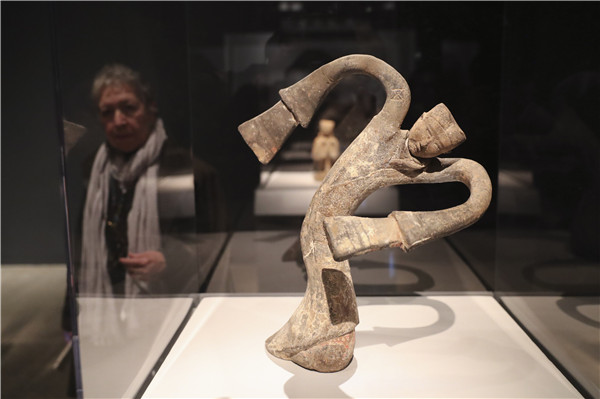
Items from a Qin and Han dynasties exhibition go on display on Monday at the Metropolitan Museum of Art in New York. The exhibition will run through July 16. (Photo by Amy He/China Daily)
The Metropolitan Museum of Art in New York City unveiled its latest exhibit to the public on Monday - a major loan exhibition of ancient Chinese art seldom seen in the West.
The collection - Age of Empires: Chinese Art of the Qin and Han Dynasties - features 164 objects from 32 museums and archaeological institutions in China. The focus is on the two dynasties' significance in establishing Chinese art, culture and politics in their time.
"The pieces are just stunning," said 75-year-old Adalaide Morris of New York. "The meticulousness of the detail is just very moving. I'm enjoying the combination of the ordinariness of the pieces and the luxuriousness of the high quality pieces that showcase true workmanship."
Morris, a retired literature professor, said that she knew very little about Chinese history before the exhibit but came away with a better understanding of Chinese crafts and the way measurements were standardized during the Qin and Han dynasties.
"If you want to know about the present and future of China, it is necessary for you to know about the past and history of China," said Wang Jun, director of Art Exhibitions China, part of the State Administration of Cultural Heritage, at a media preview of the exhibition last month.
"The Qin (221-206 BC) and Han (206 BC-AD 220) dynasties of China are the most important dynasties in Chinese history. The intellectual and political systems that were established during the Qin and Han dynasties have extended influence over China for more than 2,000 years," he said at a media preview of the exhibit.
Wang, whose institution coordinates and sponsors the export and exchange of Chinese cultural relics overseas, called Age of Empires one of the most important cultural relics exhibitions in the China-US cultural exchange.
Meiting, a 32-year-old homemaker from Singapore of Chinese descent, said that as a history and archaeology buff who is proud of her cultural heritage, she was "delightfully shocked" to see the objects at the exhibit.
"Being here in this country (for eight years), there are so many stereotypes about the Chinese, but from this exhibit I can see that we are musicians, we are amazing designers, we were so good with technology," she said.
"It makes me feel grateful and it also makes me feel like I have a responsibility to show what type of people we can be. People say that we're the land of copying, but you can see from the items that our art is original and we have to remember that we can produce original things," said Meiting, who declined to disclose her full name.
The exhibit, which took five years to put together, was sponsored by China Merchants Bank - it is the first time a Chinese corporation has sponsored an exhibition at the Met.
"To have these ancient artifacts on display en masse is a great, major highlight for Sino-US cultural exchange," said Jiao Chengyue, general manager of China Merchants Bank's New York branch.
Maxwell Hearn, chairman of the Met's department of Asian art, said the exhibit comes at a crucial time when understanding China is "becoming more and more important".
"I believe that US audiences understand that Asia represents a significant and growing part of their future, so the ability to understand the roots of Asian culture are terribly important, and the Han Dynasty represents the starting point of modern China," he said.
"It is the same kind of identity that the Roman Empire gave to the West, both in architecture and the rule of law," he added.
Jason Sun, curator of Chinese art at the Met, said that the Han Dynasty represents the "classical" era of Chinese civilization, "coinciding in importance and in time with Greco-Roman civilization in the West".
"Like the Roman Empire, the Han state brought together people of diverse backgrounds under a centralized government that fostered a new 'Chinese' identity. Even today, most Chinese refer to themselves as the 'Han people' - the single largest ethnic group in the world," he said.
The exhibit, which will be on display through July 16, is in three sections: one on Qin Dynasty art that was excavated from the mausoleum of the first Qin emperor (which also unearthed the famed army of 7,000 Terracotta Warriors); and two on Han Dynasty relics that include a Han princess' burial suite of more than 2,000 pieces, and items that illustrate the robust level of trade between China and the rest of Asia and Europe at the time.
"Many of these spectacular works have never been seen in the West, offering visitors a once-in-a-lifetime opportunity to see a fresh appraisal of the classical era of Chinese civilization," said Thomas Campbell, director of the museum.



















































